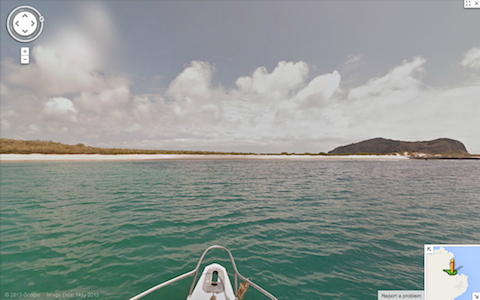As famously studied as they are, the 18 Galapagos Islands haven’t been well mapped. And research in the Galapagos, situated more than 500 miles west of Ecuador, is expensive and difficult. Maybe that’s part of the islands’ allure—that and the stunning biodiversity.
In partnership with the Charles Darwin Foundation and Galapagos National Park, Google sent a team armed with Street View Trekker cameras to create an entirely new 360 degree Street View experience that makes three major islands, a fragile tortoise breeding area and coastal areas, available to visitors located anywhere with an Internet connection.
Darwin made his first expedition to the islands 178 years ago. This might have been his first view of San Cristobal Island.

After exploring San Cristobal’s rocky coast, Google trekkers made their way to Galapaguera, a giant tortoise breeding center, where they saw newly hatched babies and adults munching on leaves and stalks.
Off the coast of Floreana Island, trekkers went underwater and caught images of seals playing in the water. They also shot images inside the Charles Darwin Research Station’s vertebrate, invertebrate and plant collections.
Google does a good job of documenting its own process. Trekkers traveled to Galapagos in May and spent 10 days hiking, boating, and diving. It’s fun to watch them climb and scoot around the islands loaded with a geodesic camera backpack.
Scientists get really excited when they find new tools to do their work. And why shouldn’t they? These islands are amazing and are home to so many unique species, like the Marine Iguana. We landlubbers may not get there anytime soon, but this is the next best thing.
Related Content:
Read the Original Letters Where Charles Darwin Worked Out His Theory of Evolution
The Genius of Charles Darwin Revealed in Three-Part Series by Richard Dawkins
Darwin: A 1993 Film by Peter Greenaway
Kate Rix writes about education and digital media. Follow her on Twitter.

